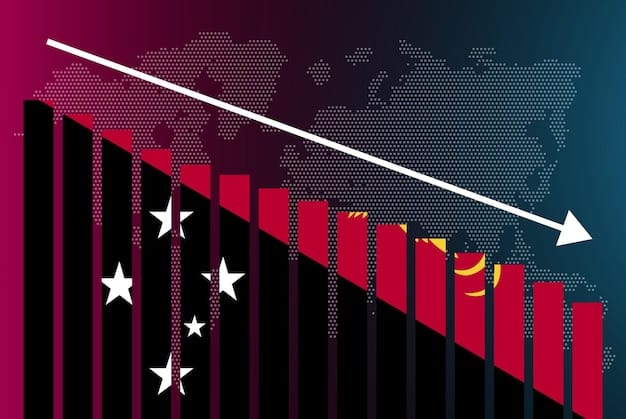US GDP Growth Forecast: Investment Strategies for 2025

The updated US GDP growth forecast of 2.5% for 2025 suggests moderate economic expansion, influencing investment strategies across various sectors as investors adjust to anticipated interest rate policies and consumer spending patterns.
The latest US GDP Growth Forecast: What the Updated 2.5% Projection Means for Your Investments in 2025 is more than just a number; it’s a roadmap for strategic investment decisions in the coming year, signaling shifts in market dynamics.
Understanding the Updated GDP Growth Forecast
The US GDP growth forecast is a critical indicator for investors and economists alike. The recently updated projection of 2.5% for 2025 warrants a thorough examination of its underlying factors and potential implications for investment strategies. This forecast provides a baseline for assessing economic health and anticipating market movements.
Key Drivers of the 2.5% Growth Projection
Several factors contribute to this forecast. Consumer spending remains a significant driver, supported by a relatively strong labor market. Business investment in technology and infrastructure is also expected to contribute, along with government spending on various initiatives.
- Consumer Spending: Drives a large portion of the GDP due to the purchasing power of the American population.
- Business Investment: Investments in technology and expansion contribute to economic productivity.
- Government Spending: Infrastructure projects and public services stimulate economic activity.
However, the forecast also considers potential headwinds such as inflation, interest rate policies, and global economic conditions. These factors could either support or detract from the projected growth rate.
Impact on Equity Markets
The equity markets are highly sensitive to changes in the GDP growth forecast. A 2.5% growth rate can influence investor sentiment and corporate earnings, leading to shifts in stock prices across different sectors. Understanding these dynamics is crucial for equity investors looking to optimize their portfolios.

Sector-Specific Performance
Different sectors react differently to GDP growth. For example, technology and consumer discretionary sectors may benefit from increased spending, while utilities and consumer staples might show more stability. Identifying these sector-specific trends is key to making informed investment decisions.
- Technology: Often sees growth due to innovation and increased business investments.
- Consumer Discretionary: Benefits from higher consumer spending amid economic expansion.
- Utilities: Tend to remain stable, providing essential services regardless of economic conditions.
Moreover, changes in interest rates can significantly impact equity valuations. A moderate growth forecast might influence the Federal Reserve’s decisions on monetary policy, affecting borrowing costs and investment returns.
Fixed Income Implications
The fixed income market is directly affected by the GDP growth forecast and the associated interest rate outlook. Investors in bonds and other fixed income securities need to assess how the 2.5% growth projection will influence yields and credit spreads. This assessment can help them make strategic decisions about their fixed income portfolios.
Yield Curve Dynamics
Changes in the GDP forecast can alter the shape of the yield curve. Expectations of higher growth and potential inflation may lead to a steeper yield curve, while concerns about slower growth could flatten or even invert the curve. Understanding these dynamics is essential for managing fixed income investments.
- Steep Yield Curve: Often signals expectations of economic growth and potential inflation.
- Flat Yield Curve: Can indicate uncertainty about future economic conditions.
- Inverted Yield Curve: Historically associated with economic slowdowns or recessions.
Additionally, credit spreads can widen or narrow depending on the perceived risk associated with different issuers. Stronger economic growth typically leads to tighter spreads, while slower growth can cause them to widen.
Real Estate Investment Strategies
The real estate market is closely tied to economic growth. The updated GDP forecast can influence property values, rental income, and investment opportunities in various segments of the real estate sector. Investors need to consider how the 2.5% growth projection will impact both residential and commercial real estate.

Residential vs. Commercial Real Estate
Residential real estate demand is often correlated with job growth and consumer confidence. A moderate growth forecast could support stable housing prices and rental rates. On the other hand, commercial real estate can benefit from increased business activity and expansion, leading to higher occupancy rates and rental income.
- Residential Real Estate: Dependent on employment rates and consumer confidence.
- Commercial Real Estate: Influenced by business growth and expansion activities.
However, rising interest rates can dampen real estate investment by increasing mortgage rates and borrowing costs for developers. Therefore, investors need to carefully evaluate the interplay between economic growth, interest rates, and real estate values.
Alternative Investments
In addition to traditional asset classes, alternative investments such as private equity, hedge funds, and commodities can offer diversification and potential returns in a moderate growth environment. The 2.5% GDP growth forecast may create specific opportunities within these alternative asset classes.
Private Equity and Venture Capital
Private equity firms often target companies that can benefit from economic growth. Sectors such as technology, healthcare, and consumer discretionary may attract private equity investment. Venture capital firms may also find opportunities in innovative startups that are well-positioned to capitalize on emerging trends.
- Technology: Attracts investment due to its growth potential and innovation.
- Healthcare: Offers stable investment opportunities due to growing demand for services.
- Consumer Discretionary: Experiences influx of capital resulting from increased revenue.
However, these investments typically involve higher risks and longer time horizons compared to traditional asset classes. Therefore, investors need to conduct thorough due diligence and assess their risk tolerance before allocating capital to alternative investments.
Navigating Uncertainty and Risk Management
While the 2.5% GDP growth forecast provides a useful benchmark, it is essential to recognize that economic forecasts are subject to uncertainty. Unexpected events, policy changes, and shifts in global conditions can all influence the actual growth rate. Investors need to implement robust risk management strategies to protect their portfolios from potential downside risks.
Diversification and Hedging Strategies
Diversifying across different asset classes and sectors can help mitigate the impact of any single event or trend. Hedging strategies, such as using options or futures contracts, can also provide downside protection. These strategies are particularly important in a dynamic and uncertain economic environment.
- Diversification: Spreads risk across various assets to reduce volatility.
- Hedging: Uses financial instruments to offset potential losses.
Moreover, staying informed about economic developments and regularly reviewing investment strategies can help investors adapt to changing conditions and make timely adjustments to their portfolios.
| Key Point | Brief Description |
|---|---|
| 📈 GDP Growth | Forecasted at 2.5% for 2025, indicating moderate economic expansion. |
| 📊 Equity Markets | Sensitive to GDP changes; tech and consumer sectors may benefit most. |
| 🏘️ Real Estate | Influenced by job growth and interest rates affecting property values. |
| 🛡️ Risk Management | Diversification and hedging are crucial in uncertain economic times. |
FAQ Section
▼
A 2.5% GDP growth forecast suggests a moderate pace of economic expansion. It implies steady but not rapid growth, which can influence decisions on business investment and consumer spending.
▼
GDP growth can impact corporate earnings, affecting stock prices. Higher growth often leads to increased investor confidence, benefiting sectors like technology and consumer discretionary more.
▼
A moderate GDP growth influences interest rates and yield curves. Investors monitor these changes to adjust their fixed income portfolios, considering potential impacts on bond yields.
▼
Real estate is impacted by job growth and interest rates. Residential demand correlates with employment, while commercial real estate benefits from business expansion, both influenced by GDP trends.
▼
Diversification and hedging are key. Spreading investments across different assets and using protective financial instruments can safeguard portfolios from potential economic downturns.
Conclusion
Understanding the implications of the updated US GDP Growth Forecast: What the Updated 2.5% Projection Means for Your Investments in 2025 is crucial for making informed investment decisions. By considering its impact on equity markets, fixed income, real estate, and alternative investments, investors can navigate the economic landscape with greater confidence and implement strategies tailored to their specific goals and risk tolerance.